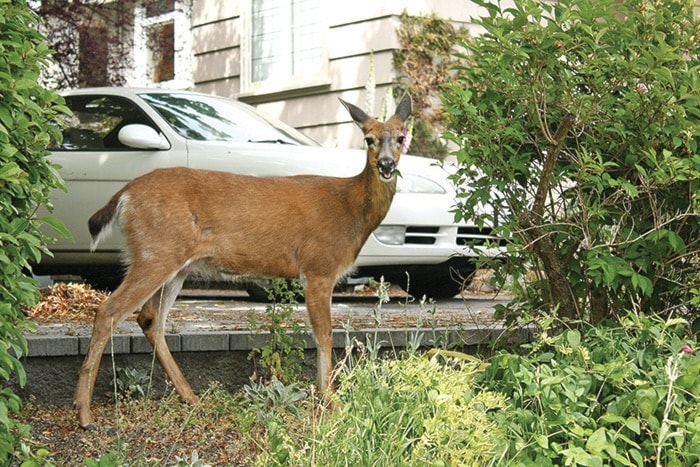How many days on average do you see deer on your property? Has there been any damage as a result of the deer? Any conflict?
Those are some of the questions residents of Esquimalt are being asked to answer as part of a survey officials hope will help determine the extent of deer activity in the community, residents’ perceptions and their attitudes regarding the animals.
Created by an independent consultant working on behalf of the township, the 24-question survey is currently being distributed to 1,100 random households by volunteers with the Urban Wildlife Stewardship Society (UWSS).
“It will just give a really complete picture of what is happening with the deer in Esquimalt and it will give council the information as to what their next steps should be, if any,” said Kristy Kilpatrick, president of the UWSS. “It collects data that will actually give specific information regarding deer movement and numbers of deer.”
The society (comprised of scientists, educators and managers with extensive senior public service experience) has been working with the township to figure out what exactly the concerns are pertaining to deer and how they should be addressed.
Last October, the society proposed a pilot project that would trap female deer, then inject them with SpayVac — a contraceptive vaccine that’s proven effective in deer and can be used to control populations.
At the time, the society had no idea how many deer were living in Esquimalt, but former president and retired biologist Bryan Gates said the problem stems throughout Greater Victoria. The deer started showing up about 10 years ago, found food and had no predators so they stayed. Now the females have established themselves.
The society is still waiting on permits from the federal and provincial government to begin the pilot, along with a host community. The group was hoping that community would be Oak Bay since the municipality faced major criticism in February 2015 over the cull of 11 deer as part of a $250,000 Capital Regional District pilot program for deer management.
Members of the society wanted to offer alternatives other than killing the animals and approached Oak Bay council last March with their plan that included public education, a deer count and the survey — which was originally prepared for Oak Bay, then re-written for Esquimalt with the help of the consultant hired by the township.
Council, however, opted not to partner with the society, for fear of it being bias. The decision, said Kilpatrick, was disappointing since the survey was drafted by an independent consultant.
“There is a lot of controversy and a lot of people who are very concerned with their gardens, but there’s also a lot of people who are managing to co-exist (with deer). Until you do a really good, proper survey on the issue, you’re not really going to be able to say what the community wants,” said Kilpatrick. “Esquimalt has been really great to work with. They are approaching this methodically — let’s engage our community first, find out if there’s concerns and if so, what those concerns are and where, and how serious those concerns are.”
Residents are asked to complete the survey by Oct. 17. The results will be presented to council in December.
